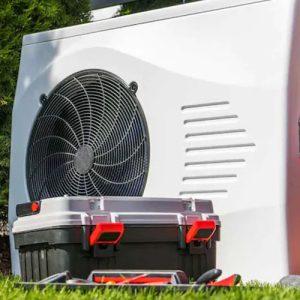 Your pool heater keeps shutting off, or the water isn’t just getting warm, and all you want is to take a dip or swim some laps. Luckily, you can often get your pool heater working again with a little decoding. Dive into our pool heater troubleshooting guide to figure out what’s wrong and when to call in a pool pro.
Your pool heater keeps shutting off, or the water isn’t just getting warm, and all you want is to take a dip or swim some laps. Luckily, you can often get your pool heater working again with a little decoding. Dive into our pool heater troubleshooting guide to figure out what’s wrong and when to call in a pool pro.
The Pool Heater Keeps Shutting Off
If your pool heater turns on but shuts off soon after, a dirty filter might be the problem. It could also be a safety switch, thermostat setting, or corroded electrical terminal. You can try a variety of solutions to remedy the issue.
Clean the Filter
Your pool heater needs enough water pressure to run properly, usually at least 40 GPM. If your heater isn’t getting a steady stream of water, it could be due to a clogged filter or dirty pump basket. Clean your filter, skimmer, and pump baskets. Turn off your heater and pump before cleaning. Remove all removable parts, remove debris, and rinse with a hose before reinstalling the piece. Turn your pool heater back on. If you still don’t have enough water pressure, consider checking your valves and safety switches.
Investigate the Safety Switches
Your pool heater might not be working due to a disabled or faulty safety switch. Consult your pool heater manual to determine where the safety switches are. The basic circuit known as the control loop houses the pressure switch, high-limit switch, gas valve, thermostat, and pilot generator. If you have experience and comfort working with electrical circuits, there’s some troubleshooting you can do. For each switch, check the voltage with a multimeter, being sure to follow safety precautions such as wearing insulated gloves and ensuring the area is dry before testing. Continue checking each switch throughout the control loop until you find the issue. If you find a switch that’s not working, use a jumper wire to bypass the switch, making solid contact with both terminals.
Adjust the Thermostat
Your pool heater’s thermostat might be set too low. Turn it up (at least above the current temperature of the pool) and see if that fixes the problem. If you have an older heater, the contacts in the thermostat might be dirty. Move the knob back and forth to clean the contacts.
Reset the Timer
Your pool heater may need more time to heat the water. Adjust the timer for a longer period and try again.
Consider the Weather
If it’s too cold outside, usually less than 60 degrees Fahrenheit, it may be too cold for your heater to run. While some pool heaters can operate in temperatures ranging from 30 degrees Fahrenheit and up, not all do. You may need to wait until warmer weather to run the pool heater.
Flip on the Plumbing Valves
Your plumbing valves should be open for water to flow to the heater. The valves are located on the connectors between the pipes that lead from the pool to the pump and heater. Check to make sure your plumbing valves are open and connected correctly.
Clean Off Corrosion
If you have an electric pool heater, check the electrical terminals for corrosion. Clean any corrosion by first turning off the heater at the power source and then scrubbing the terminals with a metal brush.
Replace Internal Parts
If your pool heater is still not working after troubleshooting other options, you may need to replace a part, such as the pressure switch, high-limit switch, heating element, or motor. Contact a local pool pro to inspect your unit. Replacing a part yourself can be tricky, and void any warranties you have. A pro can also ensure you get a compatible replacement part that won’t damage your heater.
